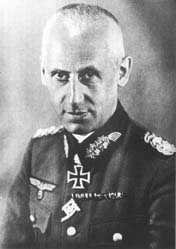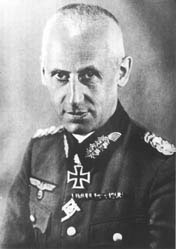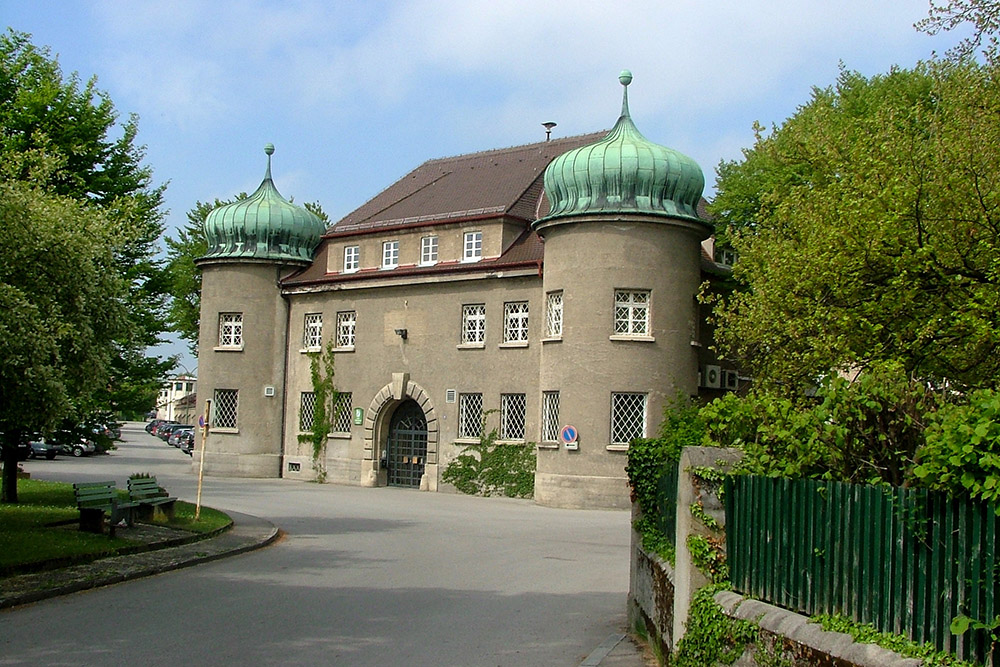Hoth, Hermann
- Date of birth:
- April 12th, 1885 (Neuruppin/Potsdam, Germany)
- Date of death:
- January 25th, 1971 (Goslar/Lower Saxony, Germany)
- Nationality:
- German
Biography
Hermann Hoth was a general of the Third Reich during World War II, notable
for victories in France and on the Eastern Front, and later, after serving
six years in prison for war crimes, as a writer on military history.
He was born in Neuruppin, the son of an army medical officer. He joined the
German Army in 1904 and served in World War I. He remained in the army
during the Weimar period, and in 1935 was appointed to command 18. Division
of the reorganized army.
Promoted to lieutenant general, he commanded the XV. Motorized Corps from 10
November 1938, leading it in the invasion of Poland the following year.
He was successful in the Western Offensive of spring 1940, and was promoted
to general on 19 July 1940.
In Operation Barbarossa in 1941, Hoth commanded Panzer Group 3, capturing
Minsk and Vitebsk, then in a shakeup in October, replaced von Stuelpnagel as
commander of 17. Armee in the Ukraine. His army was driven back by a Russian
offensive in January 1942.
In June 1942 he took over from Erich Hoepner as commander of 4.
Panzer-Armee, which fought along the Br'ansk Front and in support of the
siege of Stalingrad. He also took part in the battle of Kursk in July 1943,
but was forced to withdraw to better defensive positions.
In the autumn of 1943 the Soviet army mounted a series of successful
offensives that pushed the Germans back, and despite a distinguished record,
Hoth was blamed by Hitler for part of the losses, was reassigned to the
reserves in November.
In April 1945 he was recalled to active duty and assigned to command the
defense of the Harz Mountains, a position he held until the end of the war.
After the war, he was put on trial at the Subsequent Nuremberg Trials, found
guilty of war crimes in the High Command Trial, and on 27 October 1948
sentenced to 15 years in prison. He was released in 1954 and spent his
retirement writing. He died in 1971 at Goslar, where he is buried.
Decorations & Awards of WOI:
• Iron Cross 2nd Class 1914 (20 September 1914)
• Iron Cross 1st Classe 1914 (2 August 1915)
• Prussian Royal Hohenzollern House Order-Knight’s Cross with Swords (16 August 1918)
• Wound Badge in Black World War I
• Turkish War Medal (nicknames ‘Gallipoli Star’ in English or Eiserner Halbmond – Iron Crescent in German)
• Austrian Military Merit Cross 3rd Class with War Decoration
• Bayrisches Militärverdienstkreuz 2rd Class
• Hamburg War Merit Cross ( Hanseatic Cross)
• Bulgarian order "For Military Merit" IV Class
Do you have more information about this person? Inform us!
- Period:
- Second World War (1939-1945)
- Rank:
- General der Infanterie
- Unit:
- Kommandierender General XV.Armee-Korps
- Awarded on:
- September 21st, 1939
Had already received the Iron Cross 2nd Class on 20th September 1914.
- Period:
- Second World War (1939-1945)
- Rank:
- General der Infanterie
- Unit:
- Kommandierender General XV.Armee-Korps
- Awarded on:
- September 27th, 1939
Had already received the Iron Cross 1st Class on 2nd August 1915.
- Period:
- Second World War (1939-1945)
- Rank:
- General der Infanterie (Lieutenant-General of Infantry)
- Unit:
- Kommandierender General XV.Armee-Korps
- Awarded on:
- October 27th, 1939
6th Award.
- Period:
- Second World War (1939-1945)
- Rank:
- Generaloberst
- Unit:
- Befehlshaber 3.Panzergruppe
- Awarded on:
- July 17th, 1941
25th Award.
- Period:
- Second World War (1939-1945)
- Rank:
- Generaloberst
- Unit:
- Oberbefehlshaber 4.Panzerarmee
- Awarded on:
- September 15th, 1943
35th Award.
- Period:
- Second World War (1939-1945)
- Period:
- Second World War (1939-1945)
- Period:
- Second World War (1939-1945)
- Rank:
- Generaloberst
- Unit:
- Oberbefehlshaber der 4. Panzerarmee
- Awarded on:
- November 6th, 1942
- Period:
- Second World War (1939-1945)
- Rank:
- Generaloberst
- Unit:
- Oberbefehlshaber der 4. Panzerarmee
- Awarded on:
- November 6th, 1942
Sources
- Photo: Wilco Vermeer
- - THOMAS, FRANZ & WEGMANN, GüNTER, Die Eichenlaubträger 1940-1945, Biblio-Verlag, 1997.
- Kwasny A., Kwasny G., Die Eichenlaubträger 1940-1945 (CD), Deutsches Wehrkundearchiv, Lage-Waddenhausen, 2001
- Fellgiebel W.P., Elite of the Third Reich, The recipients of the Knight's Cross of the Iron Cross 1939-1945: A Reference, Helion & Company Limited, Solihull, 2003, ISBN 1-874622-46-9
- Go2War2.nl
- Answers.com
- Ritterkreuztraeger-1939-45.de
- Axis Biographical Research














